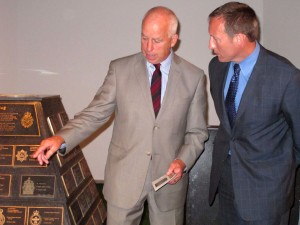By Renée Rodgers
 [1]
[1]TRENTON, On. (06/07/11) Peter Dawe, who lost his son, Capt. Matthew Dawe, in Afghanistan in 2007, shows Peter MacKay, the national minister of defence, his son's name on a memorial cairn. The cairns, which originally stood at Camp Mirage in Dubai, were officially unveiled in their new home at the National Air Force Museum July 6. Photo by Renee Rodgers.
A monument with the name of every Canadian soldier who died in Afghanistan now has a permanent home at the National Air Force Museum in Trenton.
An official unveiling ceremony was held at the museum July 6. Peter MacKay, minister of national defence, came from Ottawa to speak at the service, which was attended by members of 8 Wing Trenton and the public.
MacKay told the small crowd Trenton is an appropriate place for the monument. It is the first stop for soldiers who have died in service when they are repatriated home.
“The tarmac here in Trenton is wet with many tears from those that have lost their loved ones in a battle that has affected us all,” he said.
Col. Dave Cochrane, base commander at 8 Wing Trenton, and Lt. Gen. André Deschamps, 8 Wing chief of air staff, also spoke at the ceremony.
Among the crowd was Peter Dawe. Dawe came from his home in Kingston to watch the service, and with good reason. His son’s name, Cpt. Matthew Dawe, is among the 157 names on the memorial.
Cpt. Dawe, who served with Princess Patricia’s Canadian Light Infantry, was killed in Afghanistan July 4, 2007. An improvised explosive device detonated after a raid, killing Dawe and a number of his comrades. He was 27 years old.
Peter appeared calm and composed throughout the ceremony but he admitted in an interview it was an emotional day.
“Any time you talk about the fallen and Afghanistan in the same sentence it’s painful,” he said.
Peter Dawe attended the service to show his support for the memorial’s unveiling. He spoke with the defence minister for several minutes after the ceremony and showed him his son’s name on the monument.
The monument consists of three granite cairns, or stones. The middle cairn is in the shape of a pyramid. The other two cairns, shaped like large rectangular blocks, sit on either side. The dark grey cairns are covered with plaques, bearing the names of Canadian soldiers who made the ultimate sacrifice in Afghanistan.
The monument was created in 2006 and had originally been displayed at Camp Mirage. The camp was a semi-secret Canadian base in Dubai that shut down in 2010. The monument was shipped to Trenton at that time but had never been officially revealed to the public until the ceremony.
The cairns are displayed at the museum in the same formation in which they were arranged at Camp Mirage.
Master Warrant Officer Thomas Secretan of the Canadian Joint Incident Response Unit was at the ceremony. He was the chief of Camp Mirage from July 2003 to January 2004. He said he had met a number of Canadian soldiers who died in Afghanistan.
“I met a few guys when they were going over,” he said. “Unfortunately I was required to do their repatriation ceremony. And also when I was over there – young Cpl. Murphy. When I used to travel from Camp Mirage to Kabul, he was always my driver so I knew him quite well.”
Cpl. Jamie Murphy, from Newfoundland, was killed in Afghanistan by a suicide bomber in 2004. He was 26.
Secretan said he believes Trenton is the most appropriate place for the memorial to be displayed.
“Everything we do is a ribbon of events,” he said. “Who we are now, who we are to be, all stems from who we were. This is a large part of what we did as an air force and how we supported the combat overseas. It shows our respect to those that fell. It’s a part of who we are. Rightfully, it should be displayed in the air force museum and I’m quite proud to be here today.”
Several members of the air force were in attendance to show their respect for the 157 fallen soldiers.
Maj. Leighton James of the 426 training squadron was at the ceremony. While he has never fought in Afghanistan, he said the memorial makes him feel closer to those who have.
“For a search and rescue guy who was never in Camp Mirage and able to go, it allows me to have a physical connection with those members who went,” he said. “It is a physical representation of the sacrifice that people made.”
Canada’s combat mission in Afghanistan officially ended July 7. Some troops will stay until 2014, to conduct training missions.